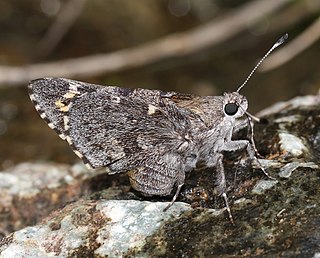
Agathymus aryxna, the Arizona giant skipper, is a butterfly in the family Hesperiidae described by Harrison Gray Dyar Jr. in 1905. Its range includes Central and North America.
Hydriomena macdunnoughi is a species of moth in the family Geometridae. It was described by Louis W. Swett in 1918 and is found in North America, where it has been recorded from Yukon Territory to western Alberta and Colorado.
Parabagrotis cupidissima is a species of moth in the family Noctuidae. It was described by Augustus Radcliffe Grote in 1875 and is found in North America, where it ranges from southern Vancouver Island, along the Pacific Coast states, to southern California. The habitat consists of grasslands and oak woodlands.
Meganola varia is a species of moth in the family Nolidae and superfamily Noctuoidea. The species was first described by William Barnes and Arthur Ward Lindsey in 1921. It is found naturally in North America, where it has been recorded throughout Arizona, New Mexico, and western Texas. While some moths of its species have reportedly been photographed in California, Meganola varia is not found on the California Moth Checklist.
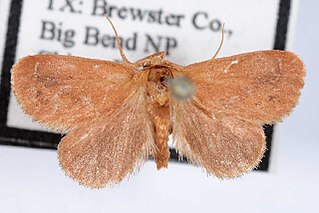
Adoneta gemina is a species of moth in the family Limacodidae, in the superfamily Zygaenoidea. It was described by Harrison Gray Dyar Jr. in 1906 from southern Texas.

Properigea niveirena is a species of moth in the family Noctuidae. It was described by Leon F. Harvey in 1876 and is found in North America, where it ranges from Vancouver Island, through western British Columbia, Washington and Oregon south to California and the border with Mexico, then east to New Mexico through southern Arizona.
Pero radiosaria is a species of moth in the family Geometridae. It was described by George Duryea Hulst in 1886 and is found in North America, where it has been recorded from southern California to Texas.
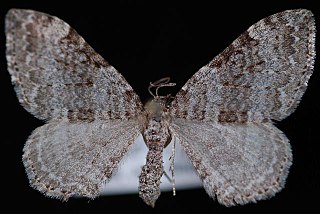
Xanthorhoe macdunnoughi is a species of moth in the family Geometridae. It was first described by Louis W. Swett in 1918 and is found in North America, where it has been recorded from open wooded areas in western North America, ranging east to western Alberta and south to California.
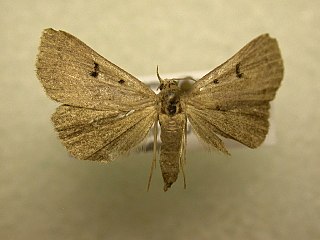
Bleptina inferior, the inferior owlet moth, is a species of moth in the family Erebidae. It was described by Augustus Radcliffe Grote in 1872 and is found in North America, where it has been recorded from Iowa to Massachusetts, south to Texas and Florida.
Annaphila arvalis is a species of moth in the family Noctuidae. It was described by Henry Edwards in 1875 and is found in North America, where it has been recorded from foothill canyons and riparian habitats in south-eastern British Columbia, eastern Washington, north-central Oregon, south to southern California.
Speyeria carolae, or Carole's fritillary, is a butterfly in the family Nymphalidae. It was described by Cyril Franklin dos Passos and Lionel Paul Grey in 1942 and is found in North America, where it has only been recorded from the Charleston Mountains of Clark County, Nevada. The habitat consists of mountain slopes, foothills and forest openings.
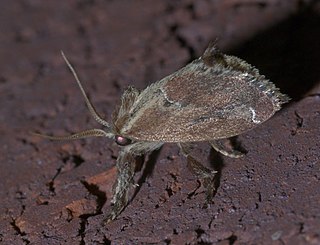
Adoneta is a genus of moths in the family Limacodidae. The genus was erected by James Brackenridge Clemens in 1860. There are at least four described species in Adoneta.

Drepanulatrix hulstii is a species of geometrid moth in the family Geometridae. It was described by Harrison Gray Dyar Jr. in 1904 and is found in North America.
Caberini is a tribe of geometrid moths in the family Geometridae. There are at least 50 described species in Caberini.

Heterocampinae is a subfamily of prominent moths in the family Notodontidae. There are at least 60 described species of Heterocampinae in North America.
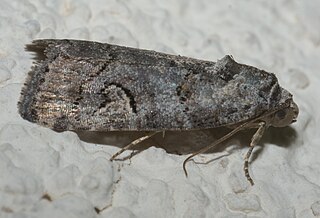
Triocnemidina is a subtribe of owlet moths in the family Noctuidae. There are about 16 genera and at least 30 described species in Triocnemidina.
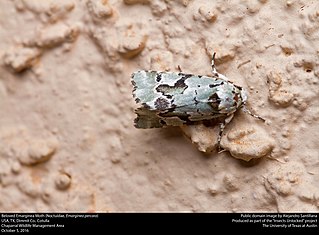
Psaphidini is a tribe of owlet moths in the family Noctuidae. There are at least 40 genera and at least 90 described species in Psaphidini.
Euamiana endopolia is a moth in the family Noctuidae. It was described by Harrison Gray Dyar Jr. in 1912 and is found in North America.
Cobubatha megaplaga is a moth in the family Noctuidae. It was described by Harrison Gray Dyar Jr. in 1912 and is found in Central and North America.
Afrida exegens is a species of nolid moth in the family Nolidae. It is found in North America.










